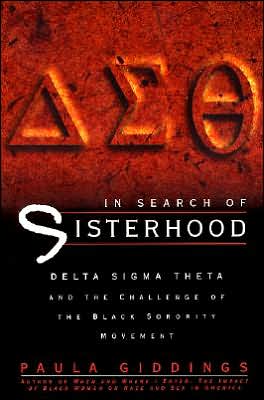In Search of Sisterhood: Delta Sigma Theta and the Challenge of the Black Sorority Movement
This history of the largest block women's organization in the United States is not only the story of Delta Sigma Theta Sorority (DST), but also tells of the increasing involvement of black women in the political, social, and economic affairs of America. Founded at a time when liberal arts education was widely seen as either futile, dangerous, or impractical for blacks, especially women, DST is, in Giddings's words, a "compelling reflection of block women's aspirations for themselves and for...
Search in google:
This history of the largest block women's organization in the United States is not only the story of Delta Sigma Theta Sorority (DST), but also tells of the increasing involvement of black women in the political, social, and economic affairs of America. Founded at a time when liberal arts education was widely seen as either futile, dangerous, or impractical for blacks, especially women, DST is, in Giddings's words, a "compelling reflection of block women's aspirations for themselves and for society." Giddings notes that unlike other organizations with racial goals, Delta Sigma Theta was created to change and benefit individuals rather than society. As a sorority, it was formed to bring women together as sisters, but at the some time to address the divisive, often class-related issues confronting black women in our society. There is, in Giddings's eyes, a tension between these goals that makes Delta Sigma Theta a fascinating microcosm of the struggles of black women and their organizations. DST members have included Mary McLeod Bethune, Mary Church Terrell, Margaret Murray Washington, Shirley Chisholm, Barbara Jordan, and, on the cultural side, Leontyne Price, Lena Horne, Ruby Dee, Judith Jamison, and Roberta Flack. In Search of Sisterhood is full of compelling, fascinating anecdotes told by the Deltas themselves, and illustrated with rare early photographs of the Delta women.Publishers WeeklyMarking the 75th anniversary of the largest black women's organization in the United States, this history of the college-based movement is an account filled with incidents of the emergence of the Deltas as a force in our national life. Giddings ( When and Where I Enter ), a graduate of Howard University, the birthplace of the movement, acknowledges the ambivalence that membership causes some, but focuses on the strengths of the sorority whose members typically remain active after college years. A sense of racial obligation permeates the sorority, which comprises women who are largely professional and upper-class, and who see their role as agents of change in a variety of social and political issues. Included among recent luminaries are Barbara Jordan, congresswoman from Texas, and, from the arts, Lena Horne, Leontyne Price and Ruby Dee. Photos not seen by PW. (August)
In Search of Sisterhood\ Delta Sigma Theta and the Challenge of the Black Sorority Movement \ Chapter One\ \ World Of The Founders\ \ \ \ On a sweltering August 2 in 1981, ten thousand members of Delta Sigma Theta sorority marched down Pennsylvania Avenue in Washington, D.C. The women, all wearing white, and many of them carrying parasols to fend off the sun, were commemorating--at this, their thirty-sixth national convention--Delta's first public act as a sorority. On March 13, 1913, just two months after their inception, the Deltas had participated in the historic woman suffrage parade on the eve of President Woodrow Wilson's inauguration.\ Two members of the Black sorority who participated in the commemoration march remembered the suffrage parade that had taken place sixty-eight years before: Sadie T. M. Alexander, then eighty-three years of age, and Bertha Pitts Campbell, who was ninety-two. In 1913, Alexander was preparing to enter the University of Pennsylvania, from which, in 1921, she would become the first Black woman to receive a Ph.D. degree.* While an undergraduate, Alexander was elected the first national president of Delta Sigma Theta, guiding its transition from a loose federation of chapters to national organization.\ Only Campbell garnered more attention as she marched down Pennsylvania Avenue on that August day. Despite her years, she refused to ride in the limousine provided for her, and only half humorously urged then national vice-president Hortense Canady to go faster or she would "walk on her heels." Campbell was the only person who had actually participated in the 1913 march. She had marched as one of the twenty-twofounding members of Delta Sigma Theta sorority. The experiences that brought her there mirrored those of a fortunate few in her generation.\ Soon after Bertha Campbell was born, on June 30, 1889, her family moved from their home in Winfield, Kansas, to Montrose, Colorado, a mining town about 180 miles southwest of Denver. It must have been a painful decision for her parents, Ida and Hubbard Sydney Pitts, to leave their wheat-filled land in Kansas. The state possessed the hopes of her Mississippi-born father as it did for thousands of southern Blacks who migrated there after the Civil War. Wheat farming was benumbing work, with a growing season that sometimes lasted two hundred days a year, but the Pittses were successful farmers--until the windswept droughts made it difficult to make ends meet. When Ida became pregnant with their third child, Bertha, they were compelled to go elsewhere. The family decided on Montrose because Ida's mother, Eliza Butler, was there, and Hubbard (or H.S. as he was called) could find a job as a cook in the gold, granite, and coal mines that had attracted a population of about a thousand. It was a young town, founded in 1882, and was an emerging service center for miners and railroad workers. In November of 1889, the couple and their three children, Charles, Minnie, and Bertha, arrived there, and it would be the birthplace of two more siblings, Huey and Timmy.\ Eliza Butler, Ida's mother, would have the most profound impact on Bertha, who would eventually live with this short, slim woman who was among the first generation of Blacks who knew both slavery and freedom. Campbell still recalls her saying that "education is the gateway to everything,"1 and Campbell took those words seriously. In 1903, she became the only Black student to enroll in Montrose High School, and five years later delivered the valedictory address to the class of 1908. In that year, she graduated summa cum laude, and was offered a full four-year scholarship to Colorado College in Colorado Springs, some 160 miles from Montrose. And Campbell would have attended that thirty-four-year-old institution if it hadn't been for a woman who was a trustee of the nearby Congregationalist church, which was attended by the Pitts family. The trustee had just been to the nation's capital and had seen Howard University. "Oh, Bertha," the woman told her, "it's the nicest school in Washington."2 She was also partial to the college because it was named after General 0. 0. Howard, a Congregationalist and Civil War hero who had been president of the university from 1869 to 1873. The general also had headed the Freedmen's Bureau, a government agency that aided newly emancipated Blacks. According to Campbell, the trustee also believed that it would be beneficial for her to be part of a Black community, an experience she had not had, since her family were the only Blacks in Montrose, and Colorado College would not be much better. Campbell protested that her family would be unable to afford Howard in lieu of the scholarship she had already received, but was told that perhaps the Church could offer her one. Campbell did get the financial support and in 1909 she found herself preparing to attend Howard.\ For the twenty-year-old Coloradoan, the Howard adventure began with a three-day train trip--including one luxurious meal in the train's dining car and a long stop in Chicago before reaching Washington, D.C. When she arrived on the campus, she must have been pleased at what she saw. Howard University, chartered in 1867, "for the education of youth in the liberal arts and social sciences," stood on twenty acres of "the highest elevation in Northwest Washington, and the most attractive part of the city," noted the Howard University Record, the official organ of the university.3 The campus looked over a small lake-sized reservoir, and the grounds of the National Soldiers Home that furnished a park. There were abundant shade trees and modern brick buildings that were "heated by steam and lighted by electricity," boasted the Record. One might also have been relieved to know that the campus and its surroundings had an enviable record of "healthfulness." No disease "has ever become epidemic in the institution," the publication proudly noted, "and there has never been on the grounds a death from typhoid."4\ In Search of Sisterhood\ Delta Sigma Theta and the Challenge of the Black Sorority Movement. Copyright © by Paula Giddings. Reprinted by permission of HarperCollins Publishers, Inc. All rights reserved. Available now wherever books are sold.
Preface5Acknowledgments11Introduction: The Importance of the Black Sorority: Some Considerations15Ch. 1World of the Founders27Ch. 2The Founding46Ch. 3Extending the Vision: Nationalizing an Idea61Ch. 4Grounds for a Movement80Ch. 5New Era, New Challenge101Ch. 6Strengthening Within - Looking Without124Ch. 7"One Blood, One Tradition"139Ch. 8From Coalition to Autonomy179Ch. 9Coming of Age194Ch. 10The Modern Sisterhood215Ch. 11Delta in the Movement Years239Ch. 12Challenge and Change259Ch. 13Toward a New Identity270Ch. 14Delta Sigma Theta, Inc.: The Contemporary Years293Notes306Appendix319Index327
\ Publishers Weekly\ - Publisher's Weekly\ Marking the 75th anniversary of the largest black women's organization in the United States, this history of the college-based movement is an account filled with incidents of the emergence of the Deltas as a force in our national life. Giddings ( When and Where I Enter ), a graduate of Howard University, the birthplace of the movement, acknowledges the ambivalence that membership causes some, but focuses on the strengths of the sorority whose members typically remain active after college years. A sense of racial obligation permeates the sorority, which comprises women who are largely professional and upper-class, and who see their role as agents of change in a variety of social and political issues. Included among recent luminaries are Barbara Jordan, congresswoman from Texas, and, from the arts, Lena Horne, Leontyne Price and Ruby Dee. Photos not seen by PW. (August)\ \







